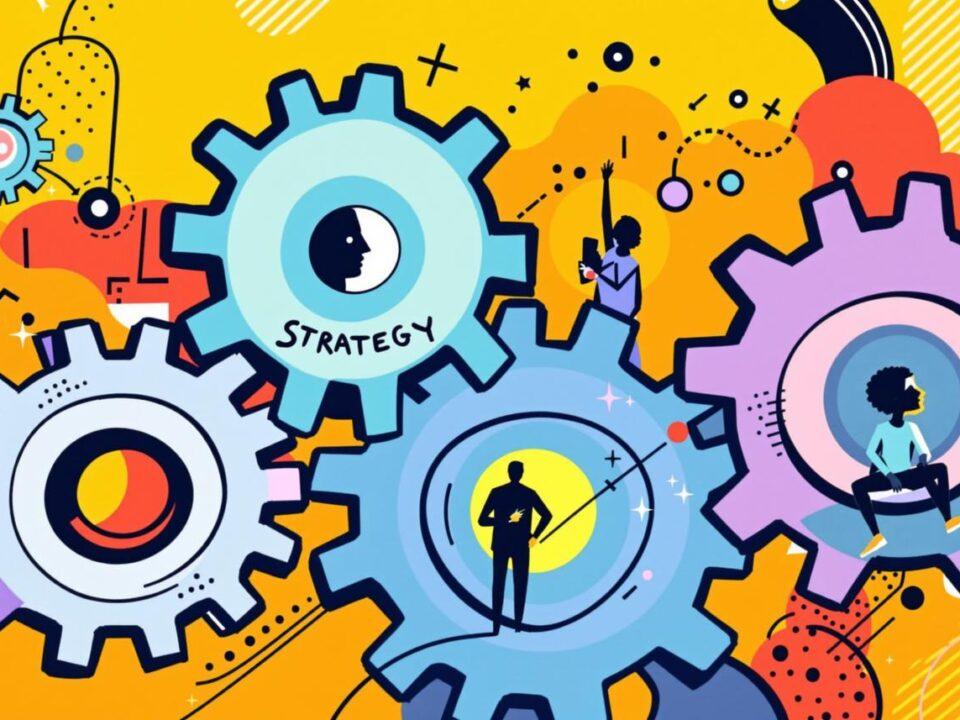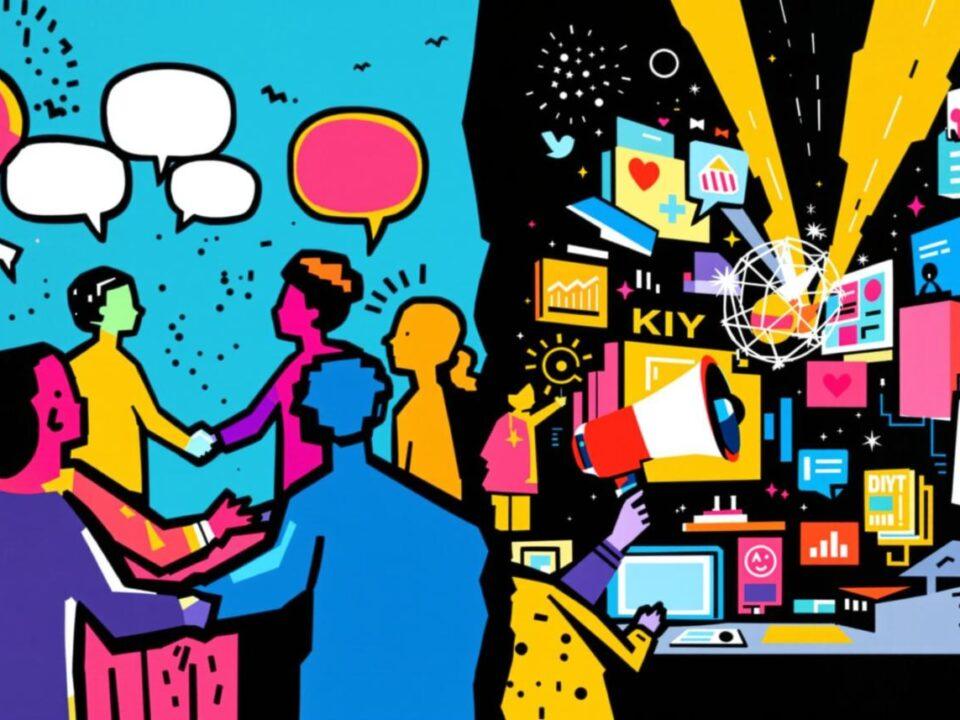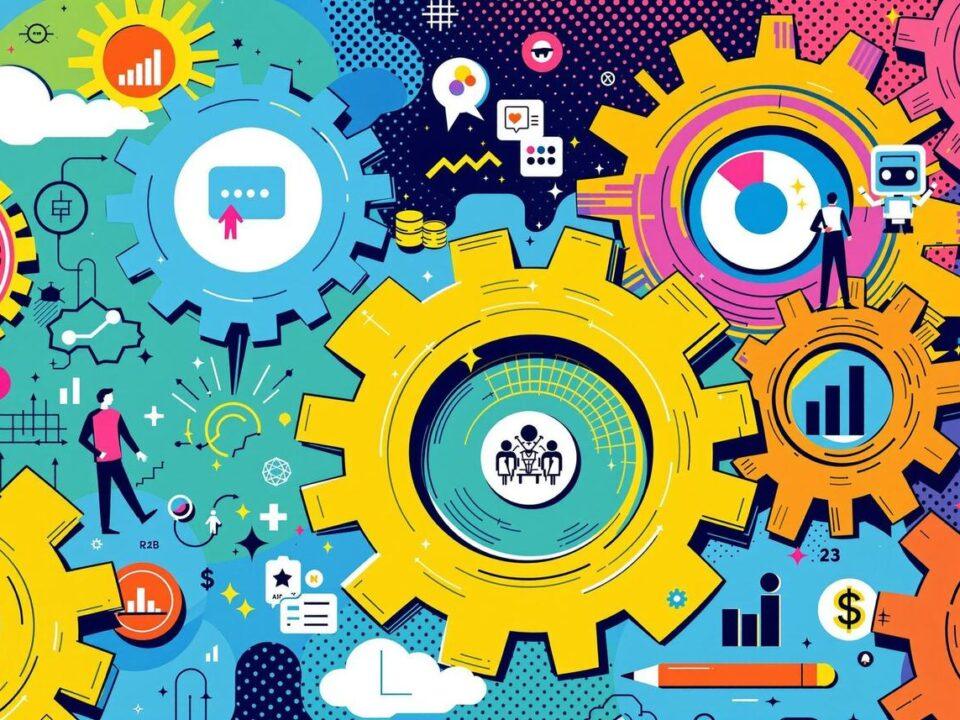B2B marketing is shifting fast, driven by AI, privacy regulations, and evolving buyer expectations. Here’s a quick breakdown of the top trends transforming strategies in 2026:
- AI-Driven Personalization: Real-time behavior analysis to craft tailored, impactful experiences, boosting ROI by 25%.
- Data Clean Rooms: Privacy-first tools for secure data collaboration, replacing third-party cookies.
- Account-Based Everything: Coordinated efforts across marketing, sales, and customer success, targeting high-value accounts.
- Influencer Collaboration: Partnering with industry experts to generate high-quality leads and build trust.
- Video and Interactive Content: Engaging formats like demos, webinars, and clickable tools to keep buyers interested.
- Predictive Analytics: Anticipating buyer behavior to refine campaigns and improve revenue alignment.
- Human-Authored Brand Tone: Balancing AI efficiency with genuine, relatable messaging to build stronger connections.
Quick Comparison
| Trend | Core Focus | Key Benefit | Adoption | Examples |
|---|---|---|---|---|
| AI-Driven Personalization | Tailored buyer engagement | Higher ROI and conversions | Growing among enterprises | Dynamic emails, predictive scoring |
| Data Clean Rooms | Privacy-compliant data analysis | Secure targeting and collaboration | Gaining traction | Amazon Clean Rooms, Google Ads Hub |
| Account-Based Everything | High-value account targeting | Streamlined sales cycles, better ROI | Widely adopted | Multi-touch campaigns, CRM tools |
| Influencer Collaboration | Expert-led partnerships | Builds trust, improves lead quality | Increasing | Webinars, co-created whitepapers |
| Video & Interactive Content | Engaging, dynamic formats | Boosts engagement and lead quality | Broadly adopted | Explainer videos, interactive demos |
| Predictive Analytics | Forecasting buyer behavior | Proactive, intent-driven strategies | Expanding rapidly | Intent signals, real-time adjustments |
| Human-Authored Brand Tone | Genuine messaging | Builds trust, improves retention | Common across industries | Thought leadership, personalized emails |
These trends emphasize precision, privacy, and personalization, helping businesses connect more effectively with B2B buyers. The future belongs to those who refine their approach now.
What’s Next for B2B Marketing | B2B Marketing Trends FY26
1. AI-Driven Personalization
Artificial intelligence has opened up new possibilities for B2B marketers, making it easier to go beyond basic demographic targeting. With machine learning, marketers can now analyze behavior and engagement in real-time, delivering tailored messages that truly connect with individual prospects.
Adoption Rate and Projected Growth
The use of AI-powered personalization tools is gaining momentum in the B2B space. According to the Gartner Marketing Symposium, companies that have adopted these tools have seen a 25% increase in ROI. This growing interest stems from the clear competitive edge these technologies provide. Modern platforms can handle massive amounts of data, including website activity, email interactions, and social media behavior, allowing marketers to create more refined and impactful personalization strategies.
Impact on ROI and Buyer Engagement
By using AI to personalize outreach, businesses are seeing stronger sales results and greater marketing efficiency. Whether it’s crafting individualized emails or creating dynamic website experiences, AI-driven personalization helps deepen buyer engagement and smooth out the customer journey.
Practical Applications in B2B Marketing
AI can be integrated across various marketing channels to maximize its impact. For instance, websites can automatically adjust content based on a visitor’s industry or previous interactions. Emails can be optimized with perfect timing and compelling subject lines. Tailored content recommendations help prospects find what they need faster. Additionally, predictive lead scoring allows sales teams to focus their efforts on the most promising opportunities. These advanced personalization techniques not only enhance the customer experience but also prepare businesses for the evolving data privacy landscape, which will be addressed in the next section.
2. Data Clean Rooms & Privacy
B2B marketers are turning to data clean rooms as a way to securely analyze customer insights without compromising privacy. These platforms allow businesses to collaborate on data analysis while enforcing strict privacy controls, which is crucial in today’s regulatory environment. This trend reflects a broader push across industries to prioritize privacy in marketing strategies.
Adoption Rate and Projected Growth
The use of data clean rooms is gaining momentum among B2B organizations. With the phase-out of third-party cookies and the tightening of privacy regulations, many companies are adopting these solutions at a fast pace. Major players like Amazon (AWS Clean Rooms), Google (Ads Data Hub), and Microsoft (Azure Data Clean Rooms) are expanding their offerings, making these platforms more accessible to enterprises looking to adapt to the new privacy landscape.
Impact on ROI and Buyer Engagement
For businesses using data clean rooms, the benefits are clear. These platforms enable secure collaboration on data, leading to better targeting, more accurate attribution, and higher conversion rates. By combining their own first-party data with partner datasets, marketers can build richer buyer profiles. The result? More personalized messaging and stronger engagement across multiple channels – all while staying privacy-compliant.
Alignment with U.S. Regulations and Market Trends
Navigating today’s privacy regulations is no longer optional. While the U.S. lacks a comprehensive federal privacy law, state-level regulations like the California Consumer Privacy Act (CCPA) and the Virginia Consumer Data Protection Act are setting important standards. On top of that, initiatives such as Apple’s App Tracking Transparency and Google’s Privacy Sandbox have reshaped how tracking works. These changes make secure environments like data clean rooms an appealing solution for marketers who want to maintain effective, data-driven strategies without breaching privacy rules.
Practical Applications in B2B Marketing
Data clean rooms unlock valuable opportunities for B2B marketers. They support secure, cross-channel analysis, helping businesses enhance account intelligence, fine-tune campaigns, and improve targeting through techniques like lookalike modeling – all while ensuring data remains anonymous and secure.
3. Account-Based Everything
The concept of account-based marketing (ABM) has grown into something far more expansive. Now, it’s all about account-based everything – a strategy that integrates personalized and targeted efforts across every stage of the customer journey. Think of it as a way to bring sales, marketing, and customer success teams together, working toward shared goals for specific accounts. Much like innovations such as AI-driven personalization and data clean rooms, this approach ensures every interaction is aligned and purposeful.
Unlike traditional marketing campaigns that aim to attract a broad audience, account-based strategies zero in on high-value accounts – those most likely to generate substantial revenue. This focus aligns perfectly with the intricate B2B buying process, where decisions involve multiple stakeholders and sales cycles often stretch over months. It’s no surprise that businesses are ramping up their investment in this approach.
Adoption and Projected Growth
More and more companies are adopting account-based strategies, expanding beyond marketing to include sales, customer success, and even product development. Why? Because these efforts lead to higher-quality leads and more efficient sales cycles.
This shift is particularly evident among enterprise-focused industries. Technology companies, professional services firms, and manufacturers are seeing some of their most impactful results from coordinated account-based efforts. By aligning their teams and resources, these organizations are closing bigger deals and strengthening client relationships.
Impact on ROI and Buyer Engagement
One of the biggest benefits of a comprehensive account-based strategy is its ability to deliver stronger ROI compared to generic campaigns. The reason is simple: it’s all about relevance.
By delivering customized, timely content tailored to specific business challenges, companies can engage buyers on a deeper level. Communications are crafted to fit the prospect’s industry, company size, and current priorities, making them feel understood and valued. This level of personalization builds trust and positions the vendor as a true partner, not just a seller.
Additionally, when marketing, sales, and customer success teams work together, they create a seamless experience for the buyer. Sharing insights and coordinating outreach ensures consistent messaging and smooth transitions throughout the sales process.
Practical Applications in B2B Marketing
The benefits of account-based strategies aren’t just theoretical – they have real-world applications across marketing, sales, and customer success.
- Marketing teams can create customized content hubs, tailored email campaigns, and highly targeted social media ads for key accounts.
- Sales teams use account intelligence to time their outreach perfectly, ensuring their efforts align with the buyer’s needs.
- Customer success teams can identify opportunities for upselling or expanding relationships within existing accounts.
To make this work, companies rely on tools like CRM systems, marketing automation platforms, and account intelligence software to track engagement and coordinate efforts. Many are also leveraging intent data and predictive analytics to identify when target accounts are actively exploring solutions.
The key to success lies in collaboration. When marketing and sales teams break down silos and work together, they can drive meaningful engagement at the account level, setting the stage for long-term success.
4. Influencer Collaboration
B2B influencer marketing has come a long way from the consumer-focused strategies of the past. Today, influencers in this space are often respected industry leaders, subject matter experts, and professionals with real authority in their fields. Instead of churning out generic promotional content, these partnerships are all about establishing trust and credibility through authentic expertise.
A report from eMarketer reveals that B2B influencer campaigns have increased qualified lead generation by 20%. This shift highlights a broader trend: business decision-makers are turning to trusted voices within their industries for guidance, research, and validation. Influencer collaborations work seamlessly alongside other personalized marketing strategies, offering multiple touchpoints that genuinely connect with target audiences. This reliance on authoritative voices has driven a noticeable rise in influencer-led initiatives.
Adoption and Projected Growth
By 2026, more B2B marketers are expected to embrace influencer collaborations as companies dedicate larger portions of their budgets to these initiatives. The focus is moving away from short-term projects toward fostering long-term relationships. For instance, some enterprise software firms have already built dedicated influencer marketing teams and launched ongoing partnership programs. These sustained collaborations often outperform traditional advertising, especially during the research phase of the buyer’s journey, where third-party validation can significantly speed up decision-making.
Practical Applications in B2B Marketing
B2B influencer partnerships go far beyond simple product endorsements. Many companies work with industry experts to create educational resources, co-host webinars, and participate in key industry events. Co-creating content – like research reports, whitepapers, or case studies – blends the influencer’s credibility with the company’s expertise, delivering meaningful value to both audiences.
Event collaborations are also becoming more popular. Companies are inviting influencers to speak at conferences, join panel discussions, or lead exclusive roundtables. Some even involve influencers in product development by seeking their feedback, which not only improves the product but also builds authentic advocacy.
The key to success lies in choosing the right partners and allowing them creative freedom. When collaborations feel genuine, they resonate more deeply with both the influencer’s audience and the brand’s target market, creating value for everyone involved.
sbb-itb-16c0a3c
5. Video and Interactive Content
Video content has become a cornerstone of B2B communication. Adding interactive elements – like polls, quizzes, and clickable hotspots – takes it a step further by letting prospects shape their own experience. This approach aligns with what decision-makers increasingly expect: engaging, fast-paced content that delivers information efficiently. It’s part of a larger trend toward dynamic, data-driven strategies, similar to the rise of AI personalization and influencer-driven campaigns.
Research shows that video is a go-to format during the research phase. Why? It breaks down complex ideas, showcases products in action, and builds a sense of connection in an otherwise digital-first environment. When you add interactive features, you give viewers the chance to dive deeper into topics that matter most to them, making the experience even more impactful.
Impact on ROI and Buyer Engagement
Video and interactive content consistently outperform static formats. They drive higher click-through rates, keep visitors engaged longer, and improve lead quality. These benefits extend across the entire sales funnel. For instance, explainer videos can grab attention early on, while interactive tools and demos help decision-makers as they move closer to finalizing a purchase.
Adoption Rate and Projected Growth
B2B marketers are quickly embracing these formats, fueled by technological advancements and shifting buyer preferences. Adoption rates are climbing as companies realize the value of video and interactive content in meeting modern buyer expectations.
Practical Applications in B2B Marketing
Marketers are finding innovative ways to weave video and interactive elements into their strategies. Beyond traditional product demos, they’re using customer success stories, behind-the-scenes videos, and executive insights to connect with their audience. Interactive webinars – complete with live polling and Q&A sessions – are gaining traction as more engaging alternatives to standard presentations.
Sales teams are also jumping on board, using personalized video messages for outreach and follow-ups. These efforts often lead to significantly higher response rates. On the content marketing side, strategies now include interactive infographics, clickable case studies, and video series designed to simplify complex topics. Some companies are even exploring virtual reality for product demonstrations, a game-changer when showcasing functionality is key to buyer understanding.
Just like AI-powered personalization and account-based marketing, video content enhances the buyer journey by offering tailored experiences. The real trick is matching the content format to what your audience needs at each stage. Early-stage prospects respond well to educational videos and interactive quizzes, while later-stage buyers appreciate detailed demos and tools that help them make informed decisions.
6. Predictive Analytics
Predictive analytics is reshaping how B2B marketers approach their strategies, turning what used to be a reactive process into a forward-thinking one. Instead of waiting for leads to show interest, marketers can now predict customer behavior, pinpoint high-value prospects, and anticipate market changes before they happen. This data-driven method not only streamlines the buyer journey but also makes it more efficient at every stage.
By analyzing historical data, predictive models can forecast outcomes with surprising accuracy. For instance, if a prospect visits specific pages on a website, downloads certain resources, or interacts with an email campaign, these models can estimate their likelihood of converting. This allows marketers to focus on promising leads while finding ways to re-engage those who might be losing interest. The result? Better engagement and measurable improvements in ROI.
Adoption Rate and Projected Growth
The enthusiasm for predictive analytics is evident. A staggering 97% of marketers see value in AI’s predictive capabilities, with half of them particularly enthusiastic about its ability to forecast market trends [3]. This optimism is backed by action – businesses are already dedicating 5% of their marketing budgets to AI analytics and pilot programs [5]. Even smaller organizations are embracing this shift, with 61% of small businesses already using AI-driven marketing tools. By 2025, AI is expected to take predictive analytics to new heights, enabling real-time personalization of content [2].
Impact on ROI and Buyer Engagement
The financial benefits of predictive analytics are hard to ignore. Companies using AI to align their sales and marketing efforts report a 34% increase in revenue, while misaligned teams can lose over 10% of their annual revenue [5]. Strong alignment doesn’t just boost revenue; it speeds up deal closures by 73% and increases win rates by 50% [5]. Beyond financial gains, predictive analytics enhances the buyer journey by identifying trends and spotting customers who might be considering other options. This allows businesses to launch retention campaigns at the right time, ultimately increasing customer lifetime value.
Practical Applications in B2B Marketing
In B2B marketing, predictive analytics is paving the way for more proactive and intent-driven outreach. By 2026, this technology will play a central role in identifying intent signals from sources like SaaS data, social media activity, and content engagement. Sales teams will be better equipped to recognize warming leads and reach out at precisely the right moment [4][1].
Predictive analytics also enables hyper-personalization on a massive scale. Marketers can dynamically adjust content, messaging, and calls-to-action based on real-time behavioral signals, creating website experiences that feel tailored to each visitor [5].
Additionally, this technology supports AI-powered co-selling by suggesting deal strategies, simulating potential objections, and crafting customized content for individual prospects [4].
Another key benefit is how predictive analytics fosters collaboration across departments. By breaking down silos between marketing, sales, and customer success teams, businesses can create unified revenue teams that share KPIs and insights. For example, AI can help allocate coaching resources based on predicted skill gaps, ensuring everyone performs at their best [4][5]. Finally, predictive analytics enhances user experiences by dynamically adjusting website messaging and highlighting relevant case studies to keep visitors engaged [5].
7. Human-Authored Brand Tone
As AI continues to play a larger role in B2B marketing, an interesting shift is taking place: brands are increasingly prioritizing a human-authored tone in their messaging. While AI excels at churning out content at scale, businesses are realizing that messages crafted by humans resonate more deeply with audiences. This growing preference highlights the need to balance the speed and efficiency of AI with the emotional and genuine touch that only human creativity can deliver.
The reason behind this shift is clear: buyers are growing weary of generic, AI-generated content and are seeking communication that feels personal and authentic.
Adoption Rate and Projected Growth
To keep up with this trend, many marketing leaders are opting for a hybrid strategy. Instead of relying solely on AI, they are investing in human content creators to complement AI tools. This approach allows companies to allocate a significant portion of their content budgets to human-authored pieces, while still using AI for tasks like research, editing, and distribution.
Small and medium-sized businesses are leading this charge, strengthening their creative teams by hiring additional copywriters and strategists. Larger enterprises are also taking note, building dedicated teams to fine-tune their brand voice and tone. This thoughtful integration of human and AI efforts not only improves brand communication but also delivers measurable business results.
Impact on ROI and Buyer Engagement
Human-authored messaging brings tangible benefits to the table. Companies that consistently use this approach across their marketing channels often see higher engagement rates, faster sales cycles, and more success in converting qualified leads.
B2B buyers, in particular, gravitate toward brands that showcase a human touch. Decision-makers value communication that feels genuine, which often results in generating better-quality leads compared to AI-only content.
Beyond lead generation, the impact extends to customer retention. Businesses that prioritize authentic, human communication often see improvements in customer satisfaction and lifetime value. In essence, human expression fosters trust and builds long-term relationships that automated messaging struggles to achieve.
Practical Applications in B2B Marketing
The advantages of human-authored messaging are evident across various aspects of B2B marketing. For instance, personalized email campaigns and tailored sales communications often lead to stronger connections with prospects. Sales teams report that messages reflecting individual thought and nuance help create more meaningful interactions.
Thought leadership content also thrives with a human touch. Pieces like industry insights, opinion articles, and strategic commentary require the depth and expertise that only seasoned professionals can provide. Companies are increasingly turning to subject matter experts to bring authenticity and authority to these types of content.
Social media is another area where human-authored content shines. B2B brands are moving away from automated, pre-scheduled posts and embracing real-time, human-driven conversations. Platforms like LinkedIn are becoming essential spaces for brands to showcase authentic voices, enhancing their reputation and driving lead generation.
Customer success communications illustrate yet another critical application. In managing complex B2B relationships, personalized responses to customer concerns, detailed success stories, and thoughtful case studies build trust and credibility. These efforts not only help with customer retention but also open doors for expansion opportunities.
Comparison Table
Businesses are moving away from older B2B marketing methods and embracing newer, more dynamic trends. This shift is reshaping how companies connect with their audiences, offering a more precise and effective approach to marketing. Here’s a breakdown of how these strategies compare:
| Marketing Area | Traditional Approach | 2026 Trend | Key Benefits | U.S. Adoption | Practical Application |
|---|---|---|---|---|---|
| Personalization | Basic demographic segmentation | AI-driven personalization | Engages audiences with content tailored to their needs | Adoption is steadily increasing among enterprises | Content dynamically adjusts to individual buyer behavior |
| Data Privacy | Dependence on third-party cookies and shared data | Data clean rooms & privacy-focused tools | Enables secure, compliant audience targeting | Gaining traction among major companies | Facilitates secure collaboration while protecting sensitive data |
| Account Targeting | Broad, industry-wide campaigns | Account-based everything | Delivers higher impact by focusing on key accounts | Widely embraced by B2B marketers | Multi-touch, coordinated campaigns for high-value accounts |
| Influencer Marketing | Consumer-focused celebrity endorsements | B2B influencer partnerships | Improves lead quality through expert-led content | Increasingly explored by B2B companies | Collaborates with industry experts for credible, insightful content |
| Content Format | Static PDFs and text-heavy whitepapers | Video and interactive formats | Drives higher engagement with immersive experiences | Broadly adopted by marketing teams | Examples include interactive demos, video case studies, and product walkthroughs |
| Analytics | Historical, reactive reporting | Predictive analytics | Optimizes campaigns proactively with advanced forecasting | Widely implemented in many departments | Anticipates buyer behavior to refine campaigns before launch |
| Content Creation | Fully automated, generic content | Human-authored, brand-focused messaging | Creates genuine, relatable content for target audiences | Common practice across content teams | Combines human creativity with AI tools for impactful storytelling |
This table highlights the evolution from generalized, traditional methods to strategies that prioritize precision, speed, and measurable outcomes. Emerging trends have shifted the focus from broad awareness campaigns to highly targeted efforts that yield faster, more meaningful results. Modern marketing leverages automation and real-time data to adapt quickly, requiring specialized skills in areas like data analytics, AI-driven tools, and technical content creation.
Additionally, metrics have gone beyond surface-level indicators like clicks or impressions. Businesses now assess success using deeper insights, such as revenue attribution, customer lifetime value, and predictive scoring. These metrics directly tie marketing efforts to tangible business outcomes, pushing U.S. companies to rethink their team structures and invest in specialists who can navigate this advanced landscape.
Conclusion
The world of B2B marketing is shifting at a rapid pace. In the U.S. alone, spending on B2B marketing is expected to rise from $49.9 billion to $70 billion by 2026 [7]. On a global scale, digital ad spending in the B2B sector is projected to reach $48.15 billion [6].
These aren’t just numbers – they reflect a deeper transformation in how businesses engage with one another. Take, for example, a financial services firm that expanded its hybrid sales team by 50%. This move resulted in nearly 10% growth in their top-line revenue [9]. Clearly, adapting to these trends isn’t optional – it’s crucial for success.
Today’s buyers are driving this change. Sixty-four percent of B2B buyers prefer digital channels, and 80% rely on digital tools for their research [8]. The global B2B eCommerce market is also on the rise, expected to hit $36.16 trillion by 2026, up from $32.11 trillion in 2025 [8]. These figures highlight the growing importance of a strong digital presence.
A whitepaper by Winterberry Group underscores how updated data strategies, fresh content approaches, and diverse channel mixes are empowering B2B marketers to make both immediate and lasting impacts [7]. To navigate this evolving landscape, businesses need more than just tools – they need expert guidance.
This is where RankWriters steps in. Offering services like competitive research, keyword optimization, and automated content delivery, RankWriters helps companies stay ahead of the curve without overburdening their in-house teams. Their expertise ensures businesses can adapt to changing trends and maintain a competitive edge.
The time to act is now. Businesses that embrace change today and invest in expert partnerships will be the ones leading the way in 2026. The future of B2B marketing belongs to those who prepare for it.
FAQs
How does AI-driven personalization boost ROI in B2B marketing?
AI-powered personalization is transforming B2B marketing by crafting tailored experiences that truly connect with potential customers. By diving into customer behavior and preferences, AI enables the delivery of content that feels relevant and timely. This approach not only enhances engagement but also improves conversion rates, leading to higher-quality leads and a shorter sales cycle. The result? Revenue growth that typically ranges between 10% and 15%.
On top of that, predictive AI tools take campaign optimization to the next level. By spotting trends and uncovering new opportunities, these tools can boost campaign performance by as much as 35%. This means marketers can allocate resources more wisely, cut down on unnecessary spending, and make the most out of their budgets – all while achieving better returns.
What are data clean rooms, and why are they important for privacy-compliant data analysis in B2B marketing?
Data clean rooms are secure digital spaces designed for businesses to collaborate on data analysis without revealing raw data or exposing personally identifiable information (PII). They play a key role in ensuring compliance with privacy laws like GDPR and CCPA, allowing companies to extract insights while safeguarding sensitive information.
In the world of B2B marketing, these tools are gaining traction because they enable companies to analyze combined datasets without breaching privacy standards. This ensures marketers can make informed, data-driven decisions while preserving customer trust and adhering to strict privacy regulations.
How does using a human-authored brand tone improve engagement and trust in B2B marketing?
Building a human-centered brand tone in B2B marketing creates stronger connections and builds trust by making communication feel more genuine and approachable. Buyers tend to engage more with brands that convey empathy, sincerity, and a personal touch in their messaging.
In a digital-first era where automation often takes center stage, a more human approach can help businesses stand out. By focusing on real interactions and a relatable voice, brands can forge deeper relationships, boost buyer confidence, and encourage lasting loyalty.







